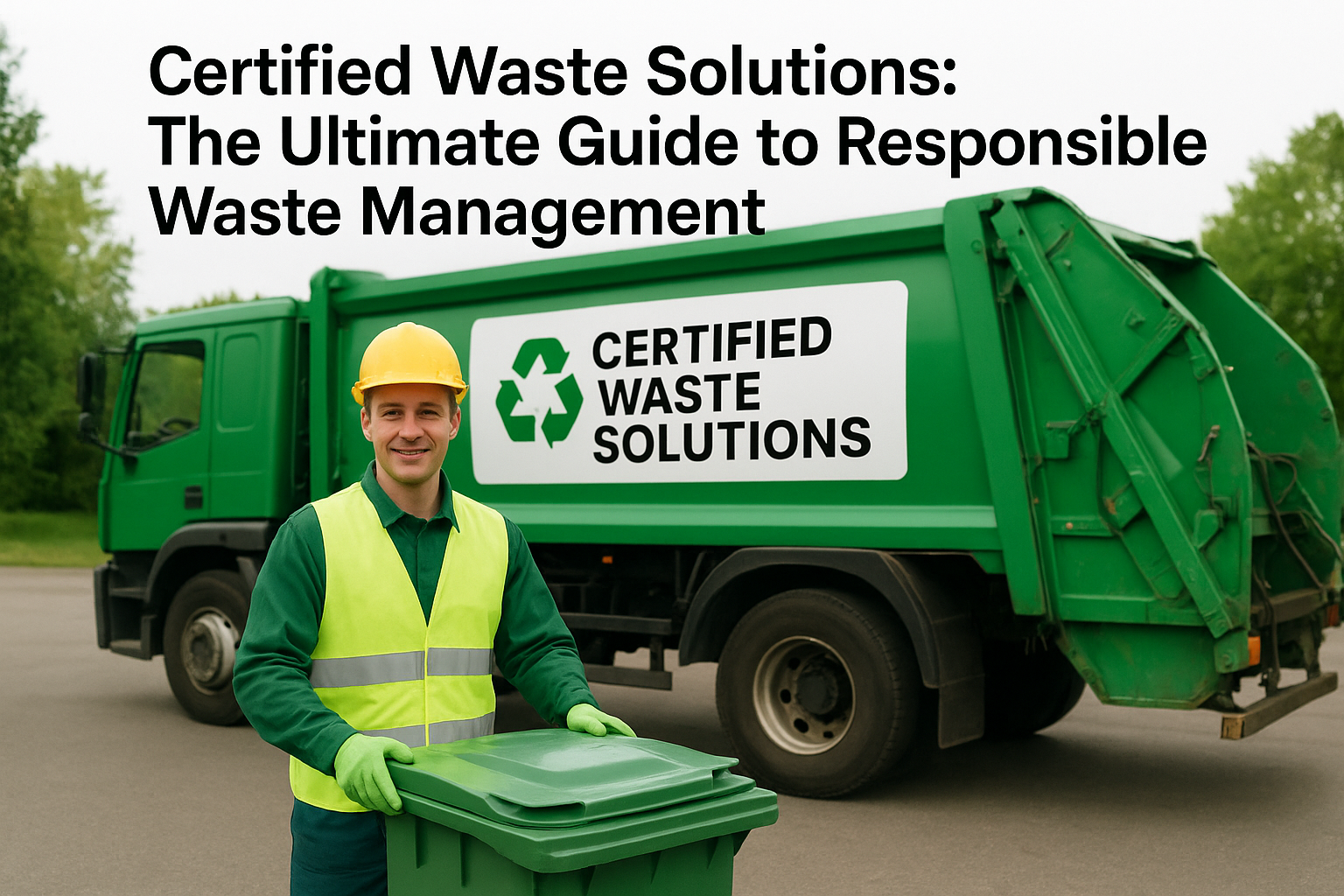
Commercial kitchens generate substantial amounts of fats, oils, and grease (FOG) that can cause significant damage to sewer systems and result in substantial fines. Many food service operators often wonder, “Is there a minimum quantity requirement to get grease recycling services?” While there isn’t a single, universal regulatory threshold dictating a strict minimum volume, the operational and regulatory frameworks surrounding pumping frequency, trap sizing, and used cooking oil (UCO) pickups naturally establish de facto service minimums. In this guide, we’ll break down what “minimum quantity” truly means in grease recycling, explore regulatory mandates, outline pumping schedules, detail UCO collection standards, share best management practices, and explain how National Waste’s integrated dumpster rental and grease services empower multi-location businesses to stay compliant, efficient, and cost-effective.
We’ll cover:
- What “minimum quantity” signifies in grease recycling (frequency, volume, sizing)
- Crucial regulatory requirements for FOG disposal and hauler compliance
- Recommended pumping intervals and effective monitoring methods
- Service-level minimums for UCO pickup and their environmental upsides
- Top practices for managing grease in commercial kitchens
- How National Waste’s unified waste solutions support large-scale operations
By grasping these key aspects, you’ll be well-equipped to optimize compliance, sidestep penalties, and streamline your grease recycling efforts alongside your essential dumpster rental needs.
What Does “Minimum Quantity” Mean in Commercial Grease Recycling?
“Minimum quantity” in the realm of grease recycling involves three interconnected elements: mandated pumping frequency to ensure FOG removal before traps reach capacity, service-level volume thresholds for used cooking oil collection, and the sizing of grease traps or interceptors, which dictates how much FOG a system can hold. Collectively, these factors establish practical limits on when and how haulers perform grease removal and oil collection, even without a single, overarching regulatory volume floor.
Commercial grease recycling services typically require: commercial services.
- Regular grease trap pumping based on capacity and FOG accumulation rates
- Minimum UCO volumes (e.g., 40 gal) for complimentary pickup
- Grease trap and interceptor sizing that triggers scheduled maintenance
This multi-faceted approach is key to preventing sewer backups, aligning with local regulations, and shaping effective service contracts, ultimately defining the true minimum quantity businesses need to meet.
How Is Grease Trap Pumping Frequency Related to Minimum Quantity?
The frequency of grease trap pumping is directly tied to the volume of FOG and solids accumulating within the trap. Regulations commonly mandate removal when the combined waste reaches 25 percent of the trap’s capacity or at set intervals (e.g., every 30, 60, or 90 days). By requiring regular service, these ordinances effectively enforce a minimum removal quantity per cycle, significantly reducing the risk of sewer blockages and odor issues.
mcdonaldfarmsinc.com
Colorado law stipulates that grease traps must be pumped at least quarterly or when they reach 20% capacity to prevent blockages and safeguard wastewater infrastructure. Non-compliance can lead to penalties, including fines and operational restrictions.
Common pumping intervals include:
- Every 30 days for kitchens with high FOG output
- Every 60 days for establishments with moderate FOG production
- Every 90 days or when the trap is 25 percent full
- Customized schedules tailored to specific flow rates and usage patterns
Consistent adherence to these intervals ensures traps never exceed legal fill limits, protecting plumbing infrastructure and preventing costly fines.
What Are the Typical Used Cooking Oil (UCO) Collection Minimums?
Haulers of used cooking oil often establish service-level minimum volumes to make pickup logistics economically feasible. While no specific UCO threshold is mandated by law, many providers require a minimum of 40 gallons for complimentary collection, applying per-gallon fees for smaller quantities.
foodhandlersguide.com
Many used cooking oil (UCO) haulers set minimum volume requirements, often around 40 gallons, for free collection, with additional charges for smaller amounts. Recycling UCO transforms waste into valuable biofuels, significantly reducing greenhouse gas emissions.
| Minimum Volume | Pickup Fee | Rebate Potential |
|---|---|---|
| 40 gal or more | No fee for scheduled pickup | Up to $0.80/gal for biofuel conversion |
| 20 – 39 gal | $0.25–$0.50/gal surcharge | Standard volume rebate rates apply |
| Under 20 gal | $1.00/gal special handling fee | Limited or no rebate available |
These hauler-defined minimums strike a balance between collection economics and environmental incentives, encouraging the bulk recycling of UCO.
How Does Grease Trap and Interceptor Sizing Affect Quantity Requirements?
The capacity of a grease trap or interceptor directly influences how much FOG a system can hold before pumping becomes necessary. Larger interceptors can delay service triggers, whereas under-sink traps in high-volume kitchens may fill up rapidly. Proper sizing, based on flow rate and peak usage, ensures traps operate within regulatory limits without frequent overflows.
| Trap Type | Capacity Range | Recommended Interval |
|---|---|---|
| Under-sink hydro-mechanical | 20–50 gal | Every 30–60 days |
| Pre-cast concrete interceptor | 500–1,000 gal | Every 90 days or when 25 percent full |
| Custom steel interceptor | 1,000+ gal | Quarterly or as per local ordinance |
Selecting the right-sized equipment minimizes service disruptions and aligns removal volumes with actual operational demands.
What Are the Key Regulatory Requirements for Grease Recycling Services?
Regulatory frameworks governing FOG disposal integrate local ordinances, state mandates, and federal guidelines to protect sewer infrastructure and water quality. These regulations specify pumping intervals, interceptor design standards, hauler licensing, waste manifesting procedures, and approved disposal methods, establishing legal parameters that indirectly enforce minimum removal quantities and service standards.
How Do State and Local FOG Ordinances Impact Minimum Quantity and Pumping Frequency?
State and municipal FOG ordinances define required pumping intervals, capacity limits, and permissible disposal routes. Some jurisdictions mandate monthly service for high-flow establishments, while others adopt a “25 percent full” rule. These local variations dictate the necessary frequency of grease removal, effectively setting a minimum volume of FOG to be handled per service cycle.
codepublishing.com
The city reserves the right to authorize maintenance work on behalf of a facility if an interceptor or separator is not properly maintained. The costs associated with such maintenance will be billed directly to the customer and will constitute a lien against the property until fully paid.
Ordinance provisions commonly include:
- Clearly defined pumping frequencies (e.g., 30/60/90 days)
- Mandatory inspection and record-keeping requirements
- Restrictions on the disposal of grease into landfills
Navigating these rules effectively requires careful attention to each location’s specific requirements.
Why Are Licensed Haulers and Waste Manifests Required for Compliance?
Licensed haulers are required to demonstrate proper training, adequate insurance, and adherence to transport regulations. Waste manifests serve as crucial documentation, recording the date, hauler, volume, and disposal method, thereby creating an auditable chain of custody. Together, these elements verify that FOG and UCO are handled responsibly, preventing illegal dumping and ensuring regulatory accountability.
Manifests typically capture the following details:
- Generator’s name and location
- Hauler’s license number and contact information
- Waste volume and composition
- Disposal or recycling facility information
Accurate manifesting protects businesses from potential liability and supports sustainability reporting efforts.
What Are Common Penalties for Non-Compliance with Grease Disposal Regulations?
Failure to comply with FOG regulations can result in significant penalties, including fines, service interruptions, and legal enforcement actions. Municipalities may impose fines based on trap capacity or the severity of the violation, and repeat offenses can lead to restrictions on sewer service or mandatory corrective actions.
- Fines ranging from $500 to $10,000 per violation
- Mandatory upgrades or repairs to interceptor systems
- Suspension of sewer service or business operations
Proactive compliance is the most effective way to mitigate these risks and ensure uninterrupted operations.
How Often Should Commercial Grease Traps Be Pumped?
Effective grease management hinges on adhering to prescribed pumping schedules that align with trap capacity, kitchen output, and local ordinances. Following established intervals prevents overflows, minimizes odors, and protects plumbing from damage, all while ensuring FOG is captured before entering wastewater systems.
Proper scheduling strikes a balance between trap fill rates, regulatory mandates, and operational efficiency.
What Are the Standard Pumping Frequencies by State or Municipality?
- Every 30 days for restaurants with high FOG output
- Every 60 days for establishments with moderate FOG generation
- Every 90 days or when 25 percent full for smaller operations
Strict adherence to local schedules is crucial for avoiding regulatory violations and preventing system failures.
How Does Kitchen Size and Activity Influence Pumping Schedules?
Grease trap pumping intervals are directly influenced by daily meal counts, cooking methods, and equipment usage. Busy kitchens featuring extensive deep-frying operations generate high volumes of FOG, necessitating monthly service. Conversely, establishments with limited menus might extend intervals to 90 days. Aligning schedules with actual grease load optimizes maintenance costs and ensures peak trap performance.
Key activity factors to consider:
- Number of customers served daily
- Prevalence of frying or high-fat cooking techniques
- Usage of low-flow fixtures and pre-treatment devices
Tailored schedules help reduce unnecessary service calls and prevent premature trap overflows.
What Are the Best Practices for Monitoring Grease Trap Levels?
Routine monitoring involves visual inspections, measuring the depth of FOG and solids, and meticulously logging the results to track fill rates. Installing automated level sensors or utilizing sight glasses can further refine service timing, ensuring pumps are scheduled before capacity thresholds are reached.
Recommended monitoring practices include:
- Conducting monthly inspections of trap contents and recording levels
- Employing calibrated dipsticks or electronic level-sensing devices
- Maintaining detailed logs to demonstrate ongoing compliance
Consistent tracking ensures that removal volumes align with actual needs and regulatory obligations.
What Are the Minimum Volume Requirements for Used Cooking Oil Collection?
Used cooking oil collection is governed by service agreements that specify minimum volumes to ensure pickup logistics and processing are economically viable. While no government regulation dictates a specific UCO threshold, haulers typically require at least 40 gallons per stop for complimentary service. Understanding these business-driven minimums is essential for kitchens to effectively plan oil storage and collection schedules.
Strategic UCO management not only reduces costs but also maximizes environmental rebates.
How Do Haulers Set Minimum Pickup Volumes and Fees?
Haulers determine minimum volumes by evaluating factors such as route density, processing capacity, and contract terms. Providers often implement tiered fee structures based on volume, offering free pickup above a certain threshold and applying surcharges for smaller quantities. These structures are designed to ensure that collection services remain economically sustainable.
Common fee structures include:
- Free pickup for quantities of 40 gallons or more per stop
- A surcharge of $0.25–$0.50 per gallon for volumes between 20–39 gallons
- A special handling fee of $1.00 per gallon for quantities under 20 gallons
Aligning collection schedules with these volume thresholds helps minimize service fees.
What Are the Benefits of Recycling Used Cooking Oil for Businesses?
Recycling UCO transforms waste into valuable biofuels, resulting in an approximate 86 percent reduction in greenhouse gas emissions compared to petroleum diesel. Businesses can benefit from participation in rebate programs, reduced disposal fees, enhanced sustainability branding, and a direct contribution to the renewable energy sector.
Key business benefits include:
- Rebates ranging from $0.30 to $0.80 per gallon collected
- Lower overall waste disposal expenses
- Strengthened corporate sustainability credentials
- Contribution to the production of renewable diesel and aviation fuel
UCO recycling effectively converts a disposal cost into tangible financial and environmental value.
How Should Businesses Store and Handle UCO to Meet Collection Standards?
Proper UCO storage in sealed, clearly labeled containers is crucial for preventing contamination and ensuring hauler readiness. Filtering out solid food particles, maintaining designated storage areas, and keeping containers within acceptable weight limits all contribute to efficient collection and safe handling practices.
Essential storage practices include:
- Utilizing food-grade, lockable drums or bins for storage
- Filtering out food particles before placing oil into storage containers
- Clearly labeling containers with collection dates and estimated volumes
Consistent handling procedures safeguard the quality of the collected oil and meet service requirements.
What Are the Best Practices for Effective Commercial Grease Management?
A comprehensive grease management program integrates employee training, the selection of appropriate equipment, and strategic partnerships with waste management providers. By combining these elements, kitchens can effectively minimize FOG generation, ensure regulatory compliance, and optimize their maintenance resources.
Holistic practices are essential for reducing blockages, controlling odors, and lowering service costs.
How Can Employee Training Reduce FOG Waste and Improve Compliance?
Training staff on proper plate scraping, the use of grease-screen filters, and the correct disposal of solid waste prevents excess FOG from entering grease traps. Regular refresher sessions and the use of visible signage reinforce best practices, thereby reducing the load on grease interceptors and extending service intervals.
Effective training encompasses:
- Instruction on proper scraping and dry-wiping techniques
- Guidance on using grease-resistant disposal bins
- Education on recognizing and avoiding prohibited disposal methods
Empowered employees play a vital role in maintaining system performance and ensuring compliance.
What Equipment Choices Optimize Grease Trap Performance and Maintenance?
Selecting equipment such as self-cleaning traps, high-capacity interceptors, or passive pretreatment systems allows for tailoring solutions to specific kitchen demands. Automated grease removal systems can significantly reduce the need for manual maintenance and extend service intervals, while integrated monitoring features alert managers before capacity thresholds are reached.
Recommended equipment features include:
- Self-cleaning mechanisms to minimize manual grease removal
- High-volume interceptors appropriately sized for peak flow rates
- Integrated level sensors for proactive service scheduling
Optimized equipment choices lead to streamlined operations and reduced long-term costs.
How Does Partnering with a Comprehensive Waste Management Provider Help?
Collaborating with a provider that offers both grease recycling and dumpster rental services simplifies logistics, consolidates invoicing, and ensures consistent service schedules across all waste streams. Integrated solutions reduce administrative overhead, enhance communication, and provide a single point of contact for regulatory support.
Key advantages of partnering with a comprehensive provider:
- A single contract covering all waste streams
- Volume-based pricing and optimized route efficiencies
- Centralized reporting and compliance documentation
Businesses benefit from enhanced consistency and economies of scale across their entire network.
How Does National Waste Support Businesses with Grease Recycling and Waste Management?
National Waste provides scalable, consolidated waste management solutions designed for businesses operating between 50 and 5,000 locations across North America. By integrating specialized FOG services with comprehensive dumpster rental offerings, National Waste ensures consistent compliance, streamlined logistics, and cost-effective operations at every site.
This integrated model is the foundation for reliable service delivery and unwavering compliance confidence.
What Are the Advantages of Consolidated Waste Management for Multi-Location Businesses?
Consolidated waste management simplifies vendor relationships by centralizing service contracts for dumpsters, grease traps, and UCO pickup. Volume discounts, unified reporting, and standardized service protocols across all locations significantly reduce administrative complexity and optimize overall waste management budgets.
Key benefits of consolidation include:
- A single, unified contract for all waste streams
- Volume-based pricing and improved route efficiencies
- Centralized reporting and streamlined compliance documentation
Businesses gain significant advantages in consistency and economies of scale across their entire operational network.
How Does National Waste Ensure Regulatory Compliance and Optimize Service Schedules?
National Waste’s dedicated compliance experts stay abreast of local FOG ordinances, manage the filing of required permits, and handle manifest documentation on behalf of clients. Data-driven route planning and the integration of level-sensor technology optimize service intervals, ensuring traps and UCO bins are serviced precisely when needed.
Our compliance and scheduling services include:
- Mapping jurisdictional ordinances and managing permit requirements
- Automated manifest generation and meticulous record-keeping
- Customized route plans informed by real-time usage data
Proactive management by National Waste helps prevent violations and maximizes operational uptime.
How Can Businesses Combine Grease Recycling with Dumpster Rental Services?
Integrating grease recycling and dumpster rental services under a single provider streamlines pickup coordination and billing, eliminates service gaps, and consolidates customer support. This synergistic approach reduces the on-site footprint and ensures all waste streams are managed to the same high standards.
| Service Combination | Benefit | Outcome |
|---|---|---|
| Grease trap pumping + dumpster rental | Unified scheduling and a single invoice | Reduced administrative overhead and complexity |
| UCO collection + mixed-waste containers | One-stop pickup for all waste streams | Improved site cleanliness and operational efficiency |
| Regulatory support + equipment maintenance | Ongoing compliance assurance and optimal equipment performance | Fewer violations and minimized service delays |
This holistic approach simplifies operations and delivers measurable cost efficiencies.
Commercial foodservice operators require clear guidance on “minimum quantity” requirements for grease recycling to maintain compliance, avoid penalties, and optimize maintenance budgets. By understanding the interplay between pumping frequency, trap sizing, and UCO volume thresholds, businesses can establish efficient service schedules. National Waste’s consolidated waste management solutions seamlessly integrate grease recycling with dumpster rental, ensuring consistent service, expert regulatory support, and cost savings for multi-location enterprises. Contact National Waste today to develop a customized grease recycling and dumpster rental program that keeps your operations running smoothly and efficiently.



